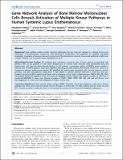| dc.contributor.author | Nakou, Magdalene | |
| dc.contributor.author | Bertsias, George | |
| dc.contributor.author | Stagakis, Ilias | |
| dc.contributor.author | Centola, Michael | |
| dc.contributor.author | Tassiulas, Ioannis | |
| dc.contributor.author | Hatziapostolou, Maria | |
| dc.contributor.author | Kritikos, Iraklis | |
| dc.contributor.author | Goulielmos, George | |
| dc.contributor.author | Boumpas, Dimitrios T. | |
| dc.contributor.author | Iliopoulos, Dimitrios | |
| dc.date.accessioned | 2011-04-27T04:07:14Z | |
| dc.date.issued | 2010 | |
| dc.identifier.citation | Nakou, Magdalene, George Bertsias, Ilias Stagakis, Michael Centola, Ioannis Tassiulas, Maria Hatziapostolou, Iraklis Kritikos, George Goulielmos, Dimitrios T. Boumpas, and Dimitrios Iliopoulos. 2010. Gene Network Analysis of Bone Marrow Mononuclear Cells Reveals Activation of Multiple Kinase Pathways in Human Systemic Lupus Erythematosus. PLoS ONE 5(10): e13351. | en_US |
| dc.identifier.issn | 1932-6203 | en_US |
| dc.identifier.uri | http://nrs.harvard.edu/urn-3:HUL.InstRepos:4878084 | |
| dc.description.abstract | Background: Gene profiling studies provide important information for key molecules relevant to a disease but are less informative of protein-protein interactions, post-translational modifications and regulation by targeted subcellular localization. Integration of genomic data and construction of functional gene networks may provide additional insights into complex diseases such as systemic lupus erythematosus (SLE). Methodology/Principal Findings: We analyzed gene expression microarray data of bone marrow mononuclear cells (BMMCs) from 20 SLE patients (11 with active disease) and 10 controls. Gene networks were constructed using the bioinformatic tool Ingenuity Gene Network Analysis. In SLE patients, comparative analysis of BMMCs genes revealed a network with 19 central nodes as major gene regulators including ERK, JNK, and p38 MAP kinases, insulin, Ca2+ and STAT3. Comparison between active versus inactive SLE identified 30 central nodes associated with immune response, protein synthesis, and post-transcriptional modification. A high degree of identity between networks in active SLE and non-Hodgkin's lymphoma (NHL) patients was found, with overlapping central nodes including kinases (MAPK, ERK, JNK, PKC), transcription factors (NF-kappaB, STAT3), and insulin. In validation studies, western blot analysis in splenic B cells from 5-month-old NZB/NZW F1 lupus mice showed activation of STAT3, ITGB2, HSPB1, ERK, JNK, p38, and p32 kinases, and downregulation of FOXO3 and VDR compared to normal C57Bl/6 mice. Conclusions/Significance: Gene network analysis of lupus BMMCs identified central gene regulators implicated in disease pathogenesis which could represent targets of novel therapies in human SLE. The high similarity between active SLE and NHL networks provides a molecular basis for the reported association of the former with lymphoid malignancies. | en_US |
| dc.language.iso | en_US | en_US |
| dc.publisher | Public Library of Science | en_US |
| dc.relation.isversionof | doi:10.1371/journal.pone.0013351 | en_US |
| dc.relation.hasversion | http://www.ncbi.nlm.nih.gov/pmc/articles/PMC2954787/pdf/ | en_US |
| dash.license | LAA | |
| dc.subject | computational biology | en_US |
| dc.subject | signaling networks | en_US |
| dc.subject | immunology | en_US |
| dc.subject | autoimmunity | en_US |
| dc.subject | immune response | en_US |
| dc.title | Gene Network Analysis of Bone Marrow Mononuclear Cells Reveals Activation of Multiple Kinase Pathways in Human Systemic Lupus Erythematosus | en_US |
| dc.type | Journal Article | en_US |
| dc.description.version | Version of Record | en_US |
| dc.relation.journal | PLoS ONE | en_US |
| dash.depositing.author | Iliopoulos, Dimitrios | |
| dc.date.available | 2011-04-27T04:07:14Z | |
| dash.affiliation.other | HMS^Pathology | en_US |
| dc.identifier.doi | 10.1371/journal.pone.0013351 | * |
| dash.contributor.affiliated | Iliopoulos, Dimitrios | |


